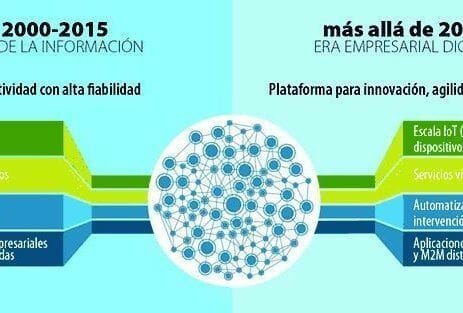Digital transformation in the company
What is Digital Transformation in the company?
We are very clear that the Internet has changed the way of doing business and the way in which we relate both personally and professionally, internally in the company, with clients, suppliers. E-mail, messaging applications, social networks ... are part of our daily life and today we cannot conceive of doing our tasks without these applications. There has been a digital transformation. The Digital Age has arrived and it is real. It represents a great opportunity for our clients, and at the same time one of the biggest challenges for IT departments. The origin of this article begins by throwing my colleagues with different functions in SOLUTEL, this question: What is the Digital transformation in the company ? Let's see the answers: 1.- For me the digital transformation is to have all the information of the organization in which you work, in the palm of your hand and computerized. Being able to access the necessary data, always with granted permissions, from anywhere (website, computer, mobile phone ...) In turn, the digital transformation of all company departments, using computer means to view, edit and share the necessary data or information. 2.- The digital transformation it is too broad a concept. Eliminate new companies already and leave those that have processes that at some point can be automated using digital resources. Save and find information, be able to talk to anyone from wherever you are at any time, deploy a project in a virtual environment to make a proof of concept and be able to serve your customers at any time from anywhere. 3.- The Digital transformation of Companies (TDE) is a way of describing the process in which a company begins to use new technologies in a positive way. From the adoption of email to complex management solutions in the cloud, every company has its IT needs. TDE occurs not only when those needs are implemented as a functional requirement, but when it goes one step further and takes into account how various solutions can streamline a business, expand work capacity, improve communications ... In summary: It is not just putting the technical patches to work, but embracing the new possibilities for improvement that new technologies allow. 4.- It is a process of INEVITABLE EVOLUTION of the business model that generates opportunities to access new markets, products and customers, defending its position against its competitors and ensuring its survival. 5.- I imagine that most people would answer that question by arguing that the Digital transformation in the company it consists of the replacement of the old way of working, more analog and with outdated tools and devices, by a more modern technology based on the Internet. That is obvious, and everyone can agree. But I think it goes further. It really changes everything. It is a way, a philosophy of work, that goes beyond the merely technical. The way of interacting between coworkers, the elimination of physical barriers, the instantaneous availability and the possibility of acting from anywhere and at any time make the possibilities of evolution of companies almost infinite. Without a doubt, here in Solutel you can see a clear example of this transformation. 6.- For me the digital transformation in the company is one more step in the evolution, he continues, of business business models, which allows the generation of new market niches and opportunities, being as competitive and efficient as possible, but never ceasing to see that first of all the companies comprise them. people, who are not machines. 7.- For me the digital transformation is to have all the information of the organization in which you work, in the palm of your hand and computerized. Being able to access the necessary data, always with granted permissions, from anywhere (web page, computer, mobile phone ...) At the same time, the digital transformation of all company departments, using computer media to view, edit and share the necessary data or information. It seems that we are clear that the digital transformation It is not having a website or company profiles in different social networks, it is not something in which only the CIO is involved, it is not having an ERP cloud ... It is changing the way of doing things, the way of doing business using technology . From the correct reflections of my colleagues, I highlight the importance of digital transformation :- Have information accessible and organized from any place and device.
- Obtain information from customers to better understand them, turn this data into useful information for the company and be able to use it. (IoT)
- Collaborate with anyone related to my company at any time from any place and device. (Mobility)
- Use new technologies to improve, streamline a business, increase work capacity and improve communications ... in short, be more competitive and efficient.
- Processes are simplified and automated, processes in general in all departments of the company are optimized and costs are reduced. When new opportunities arise, a highly digital organization can transition faster than the competition.
- Workforce efficiency and innovation are improved through automation.
- User experiences are personalized, loyalty both to employees and customers.
- The scope of the company is expanded, the forms of channels and digital points allow to reach more customers in more places around the world.
- It is a process of evolution that begins by analyzing how we currently do things and in which methods and processes could be improved.
- It is essential to know our client, what do they want? How do they want it? Where do they want it? What do they expect from us? ... and make the client the core of this process.
- Every person in the company, every department, must be involved.
- Collect information (IoT, big data) transform it into useful data for the business.
- Keep in mind metrics to act and correct deviations.
- Mobile devices. What was previously considered impossible to do on a mobile device is now the norm
- Cloud Computing: moving a significant part of your IT infrastructure to cloud services.
- Analysis platforms and Big Data. Digital organizations create terabytes of data.
- Internet of Things. ZK Research estimates that IoT will enable the connection of more than 50 billion additional devices by 2025
- Principle 1: Virtualize the network.
- Principle 2: Automate everything that drivers use.
- Principle 3: Present the contextual analysis through the network.
- Principle 4: Create applications and services for consumption in the cloud.
Share this post
Publications
related
Solutel at the 8th edition of Emplea Tech 2024
Solutel has been present at the 8th edition of Emplea Tech, the technology employment forum organized by Tajamar Tech, the technology section of Tajamar. The largest Tech attraction event, where students of VET, University and Master of Madrid have the opportunity to get in contact with leading technology companies that are...
Solutel, one more year, bets on the celebration of its internal Kick Off
Solutel, one more year, bets on the celebration of its internal Kick Off. Solutel has been celebrating its internal Kick Off for more than 15 years. Weekend dedicated to fostering team collaboration and getting to know each other better. What are the benefits for Solutel of holding the Kick Off? Align...
Joining a Webex meeting from a web browser
Do I need a webex account to join a meeting? You do not need a Webex account to join meetings to which you are invited. You can join a webex meeting from a browser. You simply need an email invitation that provides the necessary information to enter the meeting. How to join a...
Solutel wishes you Happy Holidays!
Having you on board is the foundation of our success. Once again, thank you for trusting SOLUTEL! As we enter 2024, let's toast to opportunities and successes together, and to all the good things to come. Our greatest wish is that all your projects are fulfilled, and the SOLUTEL team will be...








